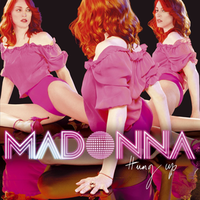
Madonna has, over the years, adapted chameleon-like to her climate. This characteristic enables her to succeed in the popular music world - where musical novelty is paramount - and "Hung Up" is a prime example of how lifting from the 70s pop style, with a beat rewired for the iPod and commercial dance generation can work effectively.
This is popular music as it's liked by many - the song would become her eleventh number one single. It can be played in a variety of contexts - on the radio at work, in the home before one goes out, via the MP3 player - thus quadrupling its appeal to the mainstream audience, for which it is intended. Through listening contexts formal and informal, thanks to the simplistic structure, reviving the sounds of 1980s pop doesn't become an exercise in pure pastiche.
The song has hazily familiar hooks, recalling traditional themes of disco - love, loss and good times - sustained overlays of the string arrangement, and keyboard melodies enveloping to administer a haze-like timbre. Paradoxically, the pulse is clear from the outset by the implementation of a metronomic tick-tock, which leads into a filtered riff, taken from Abba's "Gimme Gimme Gimme".
This lifting embodies the changing cultural identity of sampling, and its popularity quantifies why this can be seen as a piece of popular music as well. The actuality of the sample's presence can further placate public consciousness through familiarity with older values and repertoires. "Time goes by" is sung in descending pitch, with repetition of the phrase conveying a suspension of limits. The addition of delay on Madonna's vocals supplants any questioning over how fast time is passing, not to mention eliciting that the singer is trapped in an ongoing musical current, comparable to the fast-flowing nature of societal existence.
Metre and pulse co-exist comfortably as four-time and four-to-the-floor, both inextricably clear. A conventional verse-refrain structure is upheld. Madonna sings not melismata, but broken, almost static shifts between notes - "Every little thing" rises in pitch on each syllable, whereas "that you say or do" peaks and then is in descent. The convergence of themes conveys how the words are fleeting - the singer is "hung up" which can mean unstable; precariously positioned. The syncopated melodies and rhythm validates this aspect, by the contrapuntal sum of parts audible from the chorus and chugging aesthetic.
Madonna's speech is evenly distributed on the track, yet the rhythm is multilayered and as such compliments what it accentuates. A tum-tum-tum-tum ordination of the main beat is where the lyrics sit and angle off, their texture wispy, thin and spread across parameters in line with the filtering sample and chorus motif. Harmonies are consonant at 00:32-00:48, filled out and wholesome but in comparison the early section is waiting to develop a thicker skin from the intro filtration towards the main hook.
There is a definite sense that Madonna is making use of space between words, whereby she crams more into each bridging phrase in a continuum, impressioning that she's "fed up of waiting for you" (re-iterated at 01:30 for the second interval). Concerning emotions broadcast lyrically, the song is obviously written from the perspective of a girl who once had nothing, and the narrative centres around love (or rather, the lack thereof). By adhering to commonplace structure there's no doubt the message becomes more accessible, if not endearing, depending on your standpoint with commercial dance.
The dynamics are pretty standardised for the genre, but what they do conjure is fidelity. The stomp of the bass is turgid, the vocals flaccid. This juxtaposition commands your attentiveness and, combined with that Abba riff, delivers a potent, frothy and infectious airwaves-friendly cut. The tempo is fairly pedestrian - undoubtedly a stylistic side-effect of looking backwards to move forward - slow, with the texture within gaps to chorus filled by the sandworm penetration-esque melody. You could say that because of its lower key, the words in Madonna's chorus line are intensified, and translate as more uplifting, suggesting the degree to which the singer is hung up, and moreover, what path she will take to resolve it.
Ultimately, the accompaniments to the keyboard melody (sample, vocals) enshroud the piece with an overall psychedelic textural sheen. The conclusion to the clip provided (at 02:05) sees the female finally "hang up" on the significant other, adding a new chordal pattern by rising an octave, signifying the escape.


is this the one that got taken down?
ReplyDelete